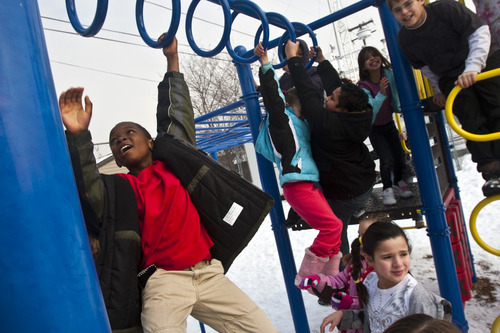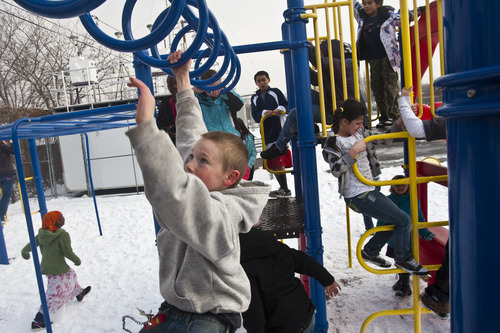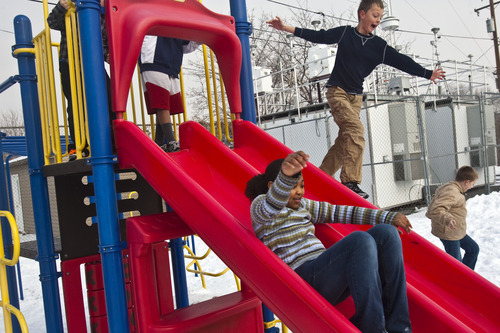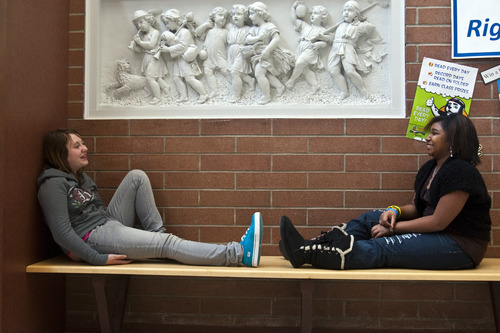This is an archived article that was published on sltrib.com in 2011, and information in the article may be outdated. It is provided only for personal research purposes and may not be reprinted.
With foul air settling into northern Utah for the rest of the week, schools are monitoring pollution levels with an eye toward canceling outdoor recess for vulnerable students.
Tuesday was the first "red" air alert of 2011 for Salt Lake and Davis counties, which means the use of wood- and coal-burning fireplaces is prohibited. And people in sensitive groups — the very young, the very old and people with heart and lung conditions — should protect their health by avoiding exertion outdoors.
The inversion is expected to strengthen through the week, said Mike Seaman of the National Weather Service's Salt Lake City office. "The front coming in Saturday should be strong enough to push the inversion out," he said. "But until then, we're stuck in soup."
At elementary schools along the Wasatch Front, principals monitor state measurements of fine-particulate matter to decide when to keep students with respiratory problems indoors and when to cancel outdoor recess altogether.
The Utah Department of Health recommends that children with congenital heart disease, cystic fibrosis, asthma or respiratory problems stay indoors when pollutants known as PM2.5 reach 35.5 micrograms per cubic meter of air, exceeding the Environmental Protection Agency's standard for healthy air.
Students expressing respiratory symptoms, including those who have colds, should stay inside when measurements hit 55.5 micrograms, according to state guidance. And it's indoor recess for everyone if particulate matter soars to 90 micrograms.
"We used to really worry just about 'red,' " said Marian Broadhead, principal of Hawthorne Elementary in Salt Lake City. "Then we got better information about the particulates. We really watch."
On Tuesday, fine particulate matter was at 32 micrograms for morning recess, Broadhead says, but it had soared to nearly 60 micrograms when the afternoon break rolled around. Sensitive students stayed inside, reading in the main office or visiting the library.
"If a student says, 'This is really bothering me' or 'I'm feeling uncomfortable,' we let that student stay in," Broadhead said. "We're trying to be really sensitive to those kinds of things."
Last year, she didn't need to cancel outdoor recess for a single day. But the year before, there were four days when particulate matter hit 90 micrograms, Broadhead said.
The state's air-monitoring equipment for Salt Lake Valley sits on Hawthorne's campus, but Broadhead checks for updates at airquality.utah.gov.
Becca Jorgensen, a Department of Health program specialist, said most schools in counties affected by air quality — Salt Lake, Davis, Weber, Utah and Cache — are familiar with the recess guidelines.
If students are kept inside, the department recommends physical activity, perhaps in the school gym, she said.
"Exercise is important," she said. "That's why we want the guidelines, too, so that [students] are not kept in on days when the particulate matter is lower."
Cherise Udell, president of Utah Moms for Clean Air, considers whether to ask Salt Lake City's Bonneville Elementary to keep her first-grader inside as soon as fine particulates reach 40 micrograms, even though her daughter doesn't have a lung or heart condition.
Last winter, she often volunteered to supervise students kept inside due to poor air quality.
She would take them to the school gym and send them running with games or laps. She hopes to organize a parent volunteer program that can be replicated at other schools.
"Kids need to get the wiggles out. It seems like the parents need to kick in at this point," Udell said. "The worst month is January, with regards to PM2.5. If we can just get through this month, then we can all breathe a little easier." —
Get involved • Want to help clear the air?
I During January, the "Care to Clear the Air" campaign encourages Utahns to reduce vehicle emissions. To set a goal and sign up for air-quality alerts via text message, go to caretocleartheair.org. —
The forecast
High pressure means an inversion will settle over the Salt Lake Valley for the rest of the week. In Salt Lake, Davis and Cache counties, use of wood- and coal-burning fireplaces is prohibited, and people in sensitive groups should avoid exertion outdoors. The health advisory is also in place for Weber, Box Elder and Tooele counties, but avoiding the burning of wood and coal is only suggested. Utah County air quality was listed as good Tuesday.
Highs in northern Utah will be in the mid-20s Wednesday and Thursday, and around 30 Friday. A storm expected to move into the region Saturday, bringing a 50 percent chance of snow, could be strong enough to clear the air.
Source • Utah Division of Air Quality,National Weather Service











